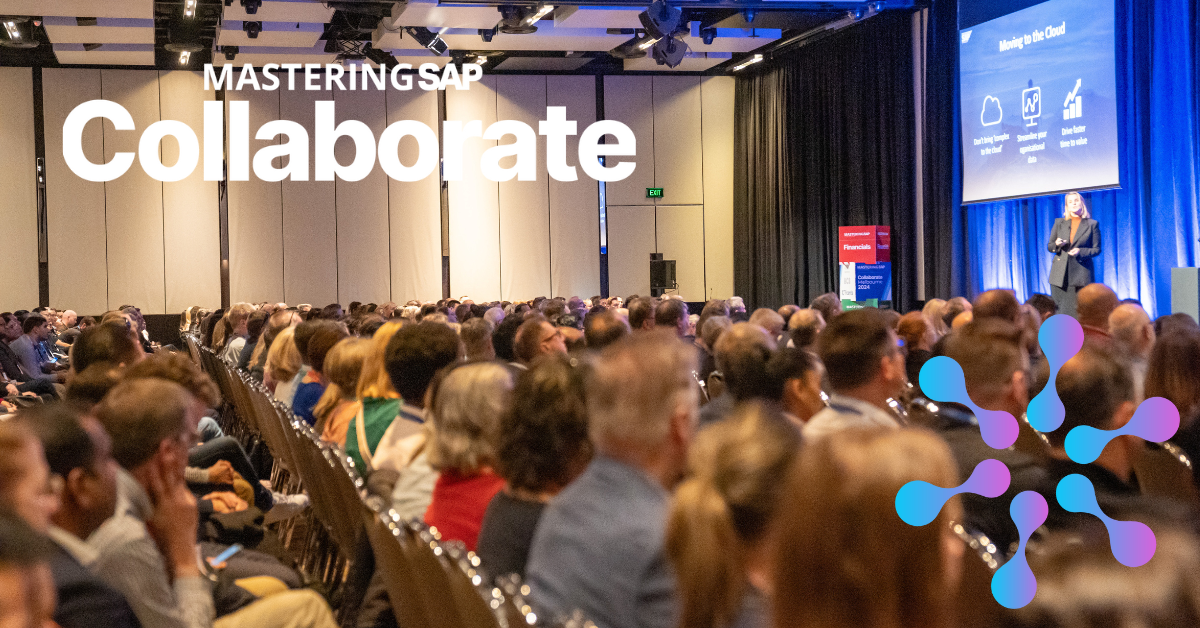SAP’s Integration Solution Advisory Methodology (ISA-M) for the Intelligent Enterprise
by Matthias Allgaier, SAP SE
A solid integration strategy is crucial for providing the flexibility and agility organizations require to meet rapidly changing business needs. When building this strategy, enterprise architects must take into account a variety of pervasive integration requirements. For example, leveraging intelligent technologies to advance business outcomes — becoming an Intelligent Enterprise, in other words — requires a foundation of seamlessly integrated business processes and data. In addition, the strategy must consider a constantly increasing integration scope as organizations add technologies such as software as a service (SaaS), cloud-based ERP, big data, Internet of Things (IoT), artificial intelligence (AI), analytics, and mobile to their existing landscapes.
For all of these reasons, integration is taking center stage as businesses pursue a digital path — in fact, Gartner predictsthat through 2020, integration work will account for 50% of the time and cost of building a digital platform. To help its customers successfully navigate the integration required for this digital journey, SAP has defined an integration strategy that embraces out-of-the-box integrations, openness, a holistic integration approach, and AI-supported integration (see the sidebar “SAP’s Integration Strategy for the Intelligent Enterprise” to learn more). As part of this strategy, SAP has introduced the Integration Solution Advisory Methodology (ISA-M).
Explore related questions
ISA-M is a methodology offered by SAP that helps enterprise architects define an integration strategy for their organizations and derive related integration guidelines. Introduced in 2014, ISA-M has been successfully applied by numerous global organizations and is constantly adapted based on customer feedback. It includes a set of technology-agnostic integration use case patterns that can be mapped to integration technologies in a customer context. This article provides an overview of ISA-M and uses a detailed example to demonstrate how enterprise architects can use the methodology based on a phased approach to create a hybrid integration platform that supports both SAP and non-SAP integration technologies.
The Integration Solution Advisory Methodology (ISA-M)
ISA-M is designed to help enterprise architects address four common challenges they typically face when designing an overall integration strategy for their organizations (see Figure 1):
-
- How do I evolve the integration architecture of my organization to be future-proof?
- How do I define a hybrid integration platform — to support both SAP and non-SAP integration technologies — to cover all the needs of my organization?
- How do I manage increasing integration demands and when do I use what integration technology?
- How do I implement an agile integration practice and empower experts outside our central integration competency center (ICC) to implement integration scenarios on their own?
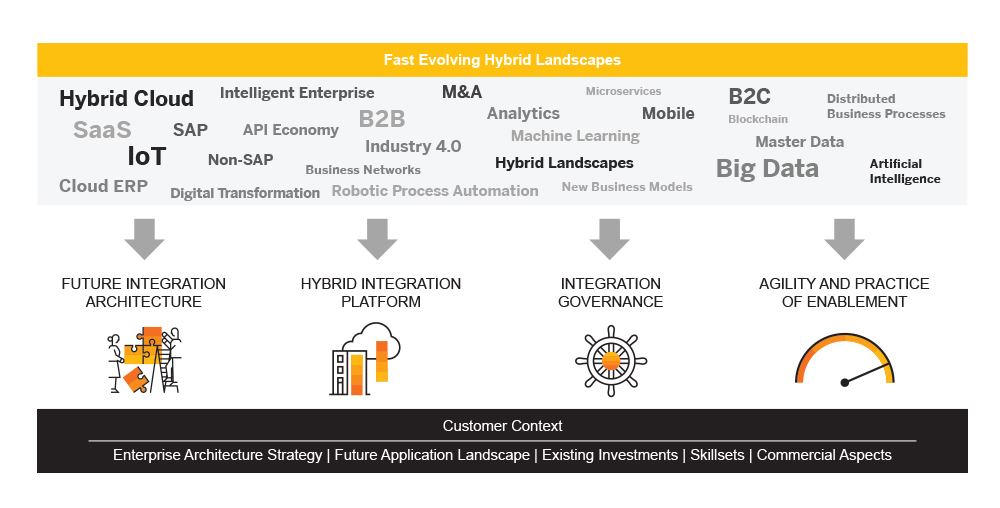
ISA-M helps enterprise architects solve these challenges by providing a simple approach — detailed in a free Microsoft PowerPoint template available from SAP that can be used as a starting point and adapted as needed — for handling a broad range of integration use cases and managing integration complexity in hybrid landscapes. Multiple global organizations have successfully adopted and extended ISA-M in their system landscapes, and the methodology is complementary to other enterprise architecture frameworks, such as The Open Group Architecture Framework (TOGAF).
ISA-M provides a collection of typical integration patterns for process-, data-, user-, and IoT-centric integration scenarios. These patterns are technology agnostic and can be mapped to integration technologies or services depending on the specific customer context, which together constitute a customer-specific, hybrid integration platform. Enterprise architects apply the methodology to define and enable this platform using a four-phase ISA-M process cycle.
Figure 2 depicts the four major phases:
- Assess your integration strategy.In this phase, enterprise architects can use ISA-M to assess their current integration architecture by analyzing typical integration domains and use case patterns in their hybrid customer landscape. This use-case-driven approach is technology agnostic and allows enterprise architects to identify future building blocks for their integration architecture.
- Design the hybrid integration platform. In this phase, the set of relevant integration use case patterns can be mapped to integration technologies and services from SAP or third-party components, based on a specific customer context. Together, these building blocks form the organization’s hybrid integration platform. ISA-M can be used to design and document the hybrid integration platform and derive customer-specific integration guidelines to support integration governance.
- Define architecture blueprints.In this phase, enterprise architects can refine important integration patterns with solution blueprints that outline involved technology components and their interactions. These blueprints can also be used as a foundation for project implementations and to bridge the gap between enterprise architecture and interface development.
- Enable the practice of empowerment. Finally, in this phase, integration guidelines and architecture blueprints can be rolled out within the organization to empower project teams to develop interfaces in an agile way based on the defined integration strategy. This phase also provides a feedback channel for incorporating lessons learned into the integration strategy.
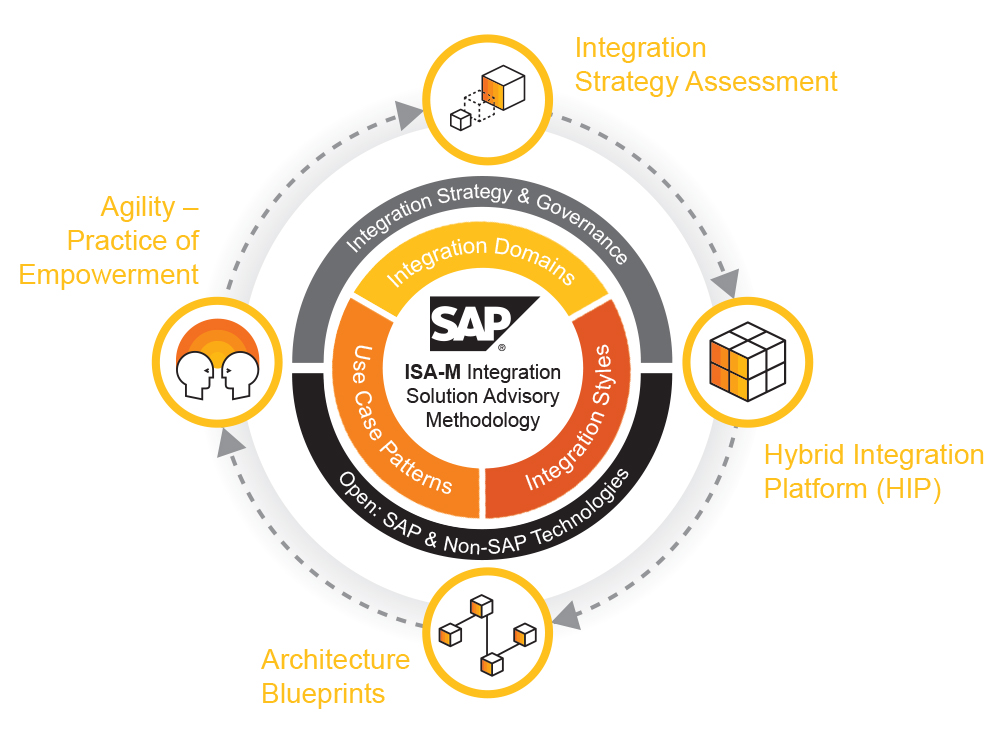
Next, we will look at each phase of the ISA-M process cycle in more detail. Note that the content of the following sections is based on the abstraction of real customer examples.
Phase 1: Assess Your Integration Strategy
There could be multiple reasons for enterprise architects to assess and refresh their integration reference architecture, such as the need to:
-
- Extend the existing landscape with new SaaS applications (both SAP and non-SAP)
-
- Transition from SAP Business Suite or SAP ERP Central Component (SAP ECC) to SAP S/4HANA
-
- Cover new integration use cases, such as the use of robotic process automation (RPA)
-
- Consolidate or modernize integration technologies
-
- Increase the integration maturity level (by establishing guidelines for integration, for example)
- Consolidate technologies due to mergers and acquisitions, for instance
To help enterprise architects assess their integration strategy, the ISA-M template provides a holistic overview of typical integration domains in a hybrid landscape (see Figure 3). Integration domains are technology agnostic and describe areas in a hybrid landscape where integration might be needed depending on the customer context. They can be used as a starting point to document a hybrid landscape and to perform a first scoping of the relevant integration areas. For example, customers can perform an assessment by selecting integration domains that are relevant for their organization or that they might want to further evaluate, for instance, as future building blocks. As ISA-M itself is extensible, customers can adapt integration domains to their specific needs. Note that in addition to supporting Phase 1, integration domains play a key role in Phase 2 when defining integration guidelines.
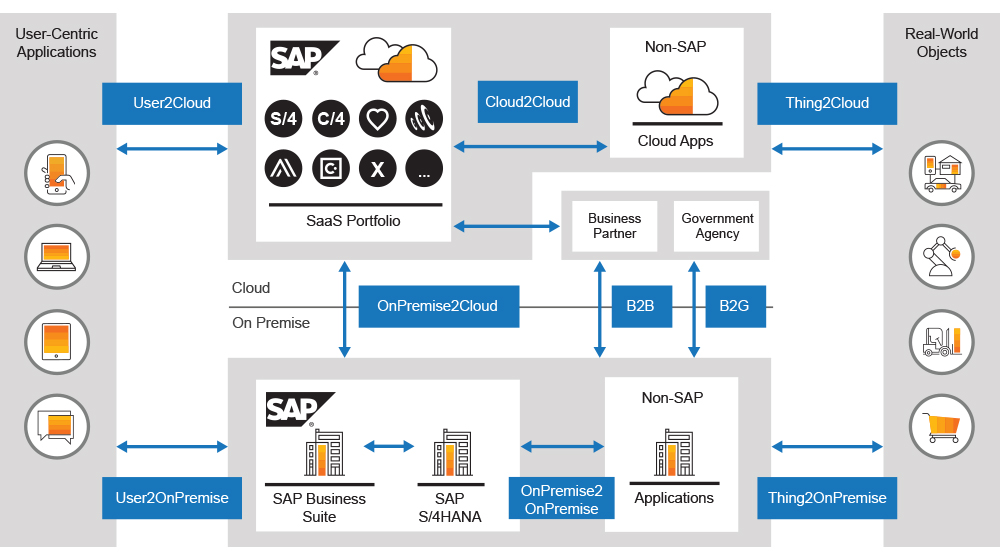
After the high-level scoping of integration domains, enterprise architects can select the integration use case patterns that are relevant to their organizations. ISA-M includes four integration styles that cover key integration archetypes (see Figure 4). The process integration style connects business processes across applications, while the data integration style allows data access and synchronization across applications. The user integration style connects user-centric applications (such as mobile apps) with applications, while the thing integration style connects real-world objects (such as sensors and machines) with applications.

Each integration style can be refined by use case patterns that describe typical integration use cases in enterprise landscapes. Cross use case patterns encompass all integration-related use cases that complement one or more of the four core integration styles. For example, the API-managed integration pattern provides full lifecycle management for application programming interfaces (APIs) that can be leveraged in user- or process-centric integration scenarios, for instance. All integration styles and use case patterns are technology agnostic and are applicable within multiple integration domains, such as in the cloud, on premise, or in hybrid scenarios.
In addition, the openness of the methodology allows enterprise architects to use the provided use case patterns as a starting point and to add or remove patterns that are not relevant.
Phase 2: Design the Hybrid Integration Platform
In this phase, enterprise architects map the integration domains, styles, and use case patterns identified in Phase 1 (all technology agnostic) to the functional building blocks of a hybrid integration platform (see Figure 5). Functional building blocks include all integration technologies and services — including both SAP and non-SAP components — that together cover the identified integration domains and use case patterns.
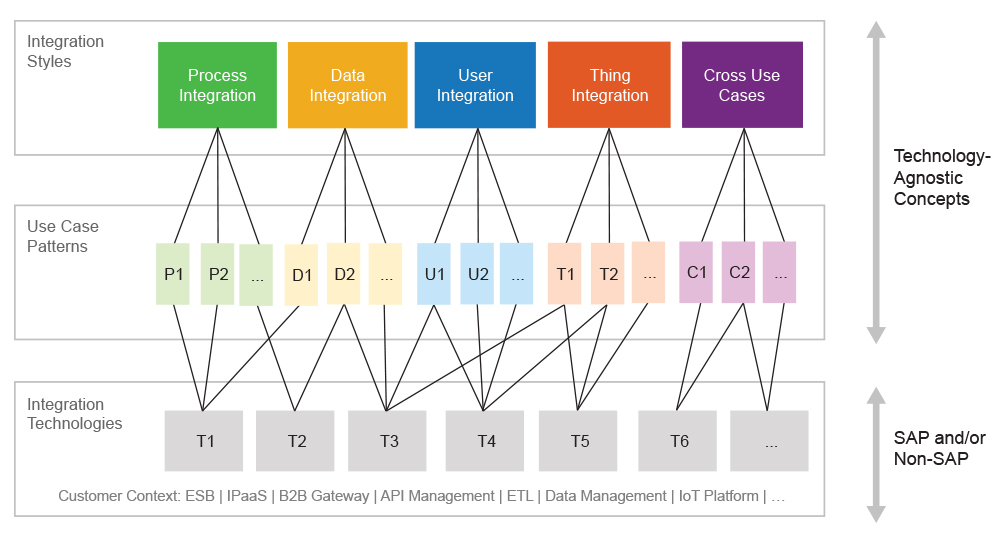
While the ISA-M template provides examples for this mapping, the mapping is highly dependent on the customer’s particular needs, such as the enterprise architecture strategy, future application landscape, existing investments, available skillsets, and commercial aspects. For example, a single integration platform as a service (IPaaS) might be enough for a simple customer landscape. A large, global enterprise, on the other hand, might require a combination of various integration technologies to cover its pervasive integration needs, such as IPaaS; enterprise service bus (ESB); API management; extract, transform, load (ETL); data management; and IoT platforms.
Figure 6 is an example blueprint of a hybrid integration platform that has been derived and abstracted from some real customer cases. The platform is hybrid in multiple dimensions: it covers multiple integration styles, multiple connected endpoints, and multiple integration domains, and supports multiple integration personas or roles. The integration technologies depicted in this example include SAP as well as non-SAP components, and they are complemented by supporting elements such as an API catalog, monitoring, integration automation, operations, and security.
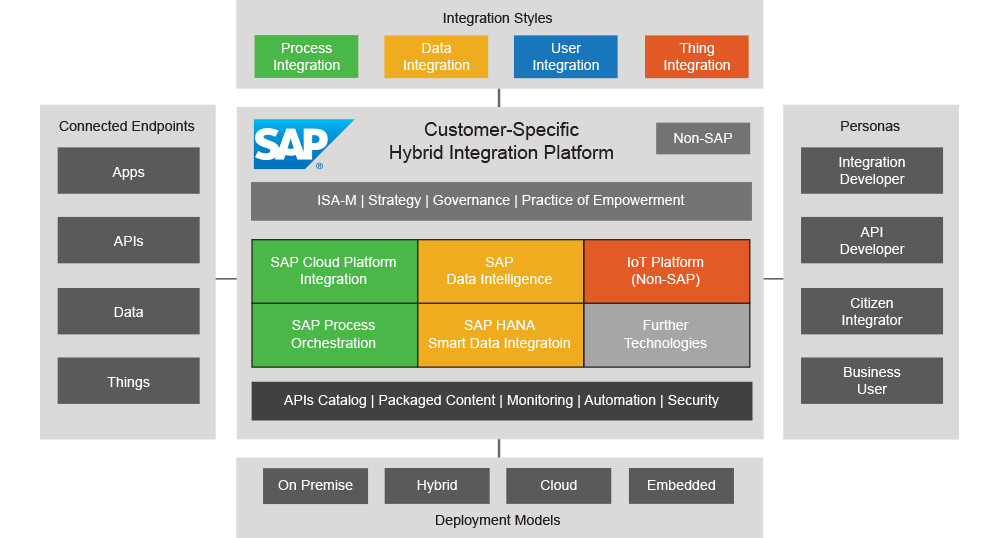
Through its business technology platform, SAP provides a holistic integration technology portfolio that covers all the integration use case patterns introduced in the previous section. Next, we will look at how SAP technology can be used to support the hybrid integration platform shown in the example, with a particular focus on the process and data integration styles, since these are core to an integration scenario. While here we focus on SAP technologies, since these are core to many organizations, remember that it would also be possible to include non-SAP or open source components in the hybrid integration platform.
SAP Cloud Platform Integration
SAP Cloud Platform Integration and SAP Process Orchestration are complementary solutions for supporting the process integration style: SAP Cloud Platform Integration covers cloud and hybrid integration domains while SAP Process Orchestration is primarily used for the on-premise integration domain. Here, we focus on SAP Cloud Platform Integration to support the hybrid scenario.
SAP Cloud Platform Integration provides a comprehensive IPaaS. It consists of a modular set of integration services that support a wide variety of integration use case patterns. These services include the SAP Cloud Platform Integration service, which supports the integration of SAP and non-SAP applications in the cloud and on premise (application to application), including integration with business partners (business to business) and government agencies (business to government). To realize out-of-the-box integration for SAP-to-SAP scenarios, SAP provides prepackaged content in SAP API Business Hub that can be deployed on the SAP Cloud Platform Integration service.
The SAP Cloud Platform API Management service provides full lifecycle management for APIs, including design and runtime governance, which allows organizations to create simple, connected digital experiences for consumers, partners, and employees. To support the openness of SAP applications, the SAP Cloud Platform Open Connectors service aims to simplify connectivity to third-party applications and accelerate integration by providing prebuilt, feature-rich connectors to over 170 non-SAP applications. The SAP Cloud Platform Integration Advisor service enables accelerated governance of message implementation and mapping guidelines, leveraging machine learning and crowdsourcing mechanisms, and the SAP Cloud Platform Enterprise Messaging service supports event-driven integrations with messaging.
Figure 7 shows an example of an integration flow (exposed on SAP API Business Hub) that can be deployed on the SAP Cloud Platform Integration service: it shows the integration of SAP Commerce Cloud (part of SAP C/4HANA) with SAP S/4HANA where orders from SAP C/4HANA are sent to SAP S/4HANA for further processing as part of an overall lead-to-cash process. This integration flow outlines a typical example for the process integration style that connects business processes across applications and guarantees transactional process integrity.
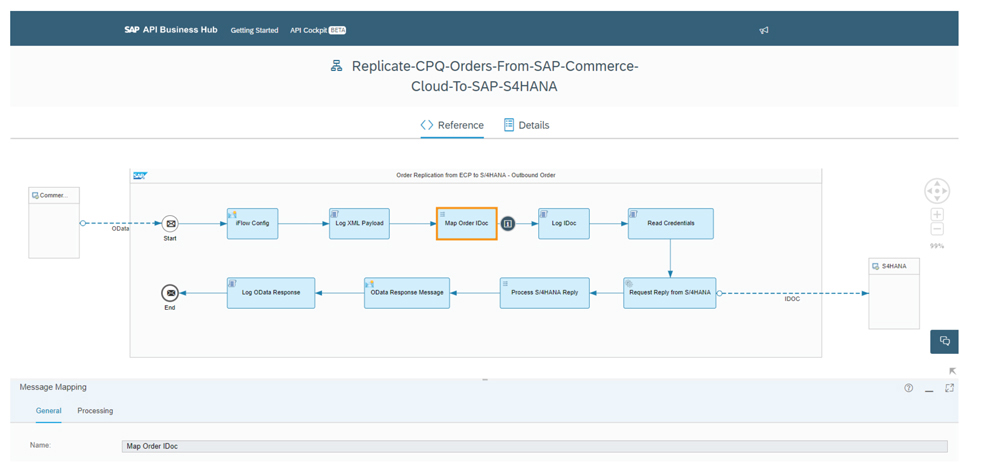
SAP Data Intelligence
The SAP Data Intelligence cloud service supports the data integration style. The example hybrid integration platform includes SAP Data Hub, which is a part of SAP Data Intelligence. SAP Data Hub provides data pipelining, governance, and landscape management of diverse data across distributed data landscapes. A metadata catalog provides the governance to get the right data to the right user, in the right context, at the right time.
In the example hybrid integration platform, SAP HANA smart data integration is included as an additional building block for the data integration style. SAP HANA smart data integration handles all data integration scenarios and should be used for ETL and real-time ETL in SAP HANA-centric system landscapes. SAP Data Hub can leverage SAP HANA smart data integration within a data orchestration scenario, making the technologies complementary.
Figure 8 shows the SAP Data Hub Modeler tool, which allows integration developers to model advanced data ingestion and transformation processing steps for data-centric integration scenarios. For example, it enables the ingestion of data from multiple source systems, including databases such as SAP HANA, message queues such as Apache Kafka, and data storage systems such as the Hadoop Distributed File System (HDFS) and Amazon’s Simple Storage Service (S3). Data can be cleansed and transformed to a specific target schema and then stored in the target systems for consumption, archiving, and analysis. Users can model data processing pipelines as a computation graph, where nodes represent operations on the data, while edges represent the data flow.

When to Use Which?
So, when do you use which? SAP Cloud Platform Integration and SAP Data Intelligence are complementary offerings that target specific integration use cases with their specific integration capabilities. While the decision is highly dependent on the particular customer context, Figure 9 provides enterprise architects some overall guidance on when it makes sense to use each offering.
Phase 3: Define Architecture Blueprints
Based on the design of the hybrid integration platform, enterprise architects can attach blueprints to selected use case patterns that outline the involved components and their interactions. These architecture blueprints can then be used by project teams for consistent implementation and documentation of integration scenarios.
Figure 10 shows a sample architecture blueprint for the digital integration hub use case pattern. With this emerging use case pattern, customers can reduce the cost and complexity of enabling API access to data held in system-of-record applications for large-scale, high-performance scenarios. By storing an aggregated snapshot of the system-of-record data needed by the channel applications, this pattern protects the system of record from excessive workloads while optimizing the data access latency and responsiveness for modern digital applications.
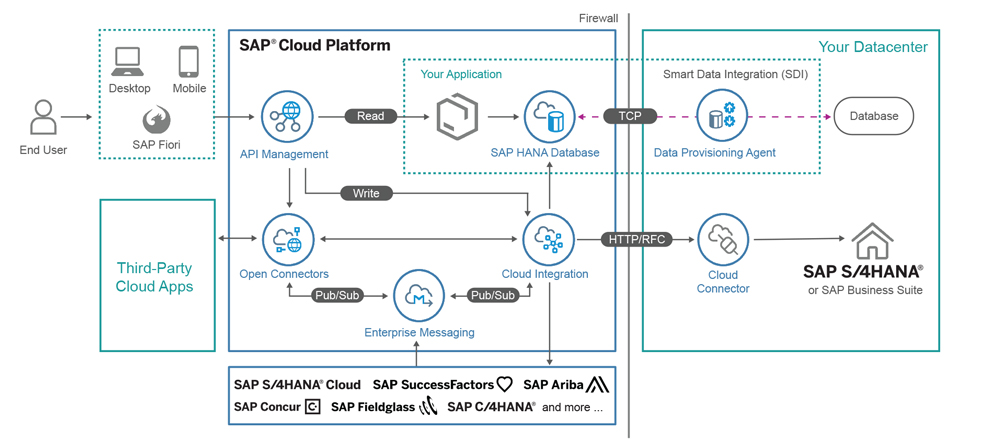
The example outlines how this use case pattern can be implemented using the services of SAP Cloud Platform Integration. Data from the back end is replicated into SAP Cloud Platform, which provides high-performance access through the SAP Cloud Platform API Management service and, in turn, decouples the front-end APIs from the back end (SAP S/4HANA, for example). Updates can be processed by the SAP Cloud Platform Integration service, which integrates with the relevant back-end and cloud applications. In addition, business events can be processed by the SAP Cloud Platform Enterprise Messaging service, which leads to updates in the SAP HANA database. Third-party applications can be integrated into this pattern using the SAP Cloud Platform Open Connectors service.
Phase 4: Enable the Practice of Empowerment
Lastly, ISA-M helps enterprise architects with the challenge of rolling out the integration strategy and enabling it within the organization (see Figure 11). Instead of following an ad-hoc integration approach, with ISA-M, enterprise architects can follow a methodical approach that ensures a mature and successful integration strategy rollout:
-
- Organizations can leverage ISA-M to document their integration architecture to improve communication between project teams and systems integrators.
-
- ISA-M can be used to define an organization’s integration strategy, as described in this article. This could help to establish integration as a recognized discipline within an organization and leverage integration as a competitive differentiator by embedding ISA-M into an ICC.
-
- Integration guidelines can be established within an organization that could be enriched with solution architecture blueprints and further best practices, such as integration governance.
- ISA-M can help embed integration into an organization’s general culture and help it embrace integration development outside of a traditional ICC. In this case, ISA-M can be used to scale the integration strategy within the organization and empower integration personas outside of the ICC to do some integration on their own, such as self-service integration by citizen integrators (business users without integration expertise).
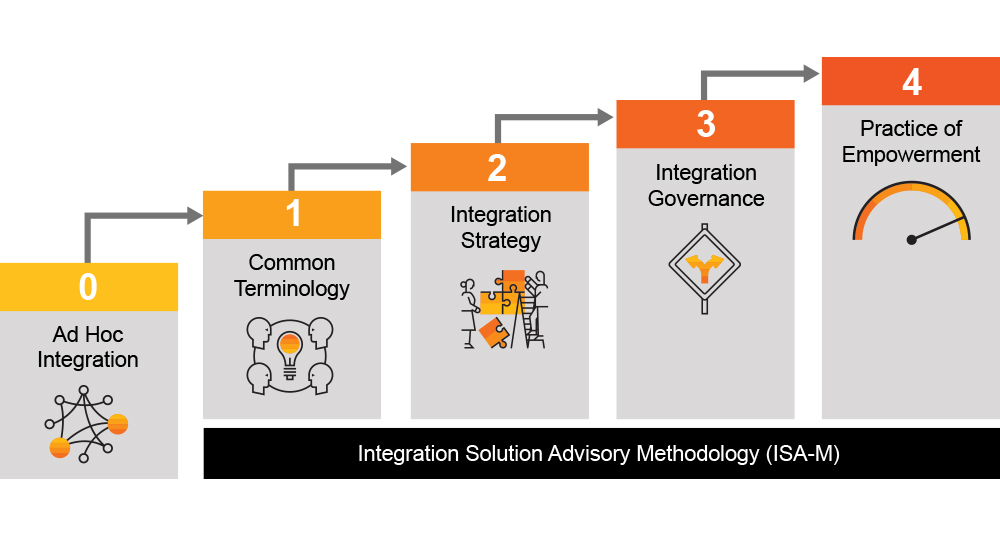
Get Started
Developing an integration strategy is a critical undertaking. To help organizations succeed at this task, SAP provides the detailed guidance included in ISA-M and resources such as the CIO guide “Process and Data Integration in Hybrid Landscapes” . This guide includes information on process, business-to-business, and data integration, as well as information on SAP’s API strategy, integration automation, and transitioning from SAP Business Suite to SAP S/4HANA.
SAP customers and partners that want to explore and adopt ISA-M in their organizations, projects, or services can use the free template available from SAP as the basis for blueprinting a customer-specific hybrid integration platform as described in this article, and can extend it to suit specific needs. Learn more about ISA-M and how to access the template at https://bit.ly/ISA-M.








